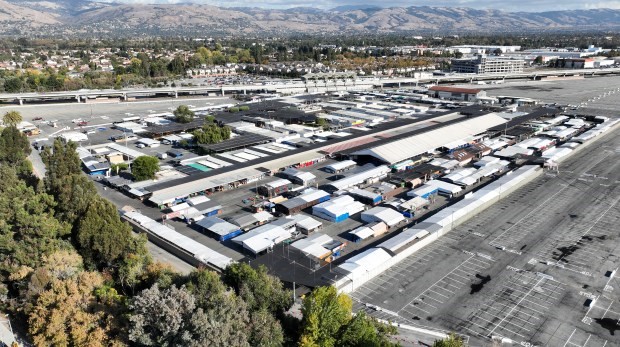Developers used housing loophole to try to scale back housing proposals

The Berryessa Flea Market in San Jose, Calif., on Tuesday, Nov. 7, 2023. (Nhat V. Meyer/Bay Area News Group)
By KATE TALERICO | Bay Area News Group
PUBLISHED: February 2, 2024 at 4:56 p.m. | UPDATED: February 5, 2024 at 4:49 a.m.
San Jose is the most recent city to fight back against the “builder’s remedy,” an obscure provision of state law that allows developers to build projects of any height and size almost anywhere in cities without a state-certified housing plan. But unlike some other places, the city doesn’t want to block housing units from getting built — it wants to win them back.
This week, the city sent letters of rejection to developers who used the builder’s remedy after June 20, including to some who tried to scale back previously approved housing projects, telling them that they will not proceed with their applications. The move opens the door to a legal battle over the future of major urban development projects around the city.
“Builder’s remedy is about enabling more housing construction, not downzoning,” said Mayor Matt Mahan in an interview.
Developers of 29 housing projects around San Jose have taken advantage of the “builder’s remedy” since San Jose failed to submit its “housing element,” a blueprint for its future residential growth that the state requires cities to revise and resubmit every eight years, by the deadline last January. The city finally came into compliance this Monday when the state signed off on its plan.
Of the 29 plans submitted in the last year, nearly a third would downsize projects previously approved by the city, putting 4,177 previously-approved units on the chopping block.
Most notable among them is the Berryessa BART Urban Village at the San Jose Flea Market site, where the developer asserted the builder’s remedy to reduce the scope of the project to 940 housing units from the 3,450 originally proposed — a move that Mahan has said “decimates” one of the city’s signature transit-oriented projects.
“There’s so much investment in that infrastructure right there,” said Chris Burton, who heads San Jose’s planning department. “It’s such a unique opportunity to place high-density employment and housing on a transit line.”
“The public sector has done our part by investing billions of dollars in the transit infrastructure connecting BART to Berryessa, now it’s time for our development partners to do their part by producing dense housing and jobs near the station as they committed to do,” Mahan previously told The Mercury News.
San Jose’s argument hinges on two points.
First, they argue that the city’s housing element was in “substantial compliance” with state law from the moment that the City Council adopted it on June 20 — and that any builder’s remedy applications submitted after that would be moot.
But housing experts say that argument could be flimsy. A court recently sided with a developer who filed suit against La Canada Flintridge when it used the same rationale, deciding that a city is subject to the builder’s remedy until the state gives its official sign-off on a housing plan. California’s Department of Housing and Community Development has reaffirmed that stance in its own memos.
The city’s second argument is more novel. In its letter to the Berryessa BART developers, San Jose argues that builder’s remedy does not apply for projects that wouldn’t help the city to meet its housing production goals. In other words, the city is asking: Why would builder’s remedy, a penalty levied on cities that aren’t building enough housing, apply to a project seeking to build fewer units?
“The tool is intended to create housing, not to reduce housing,” said Mathew Reed, policy director of the pro-housing SV@Home.
But Erik Schoennauer, the land-use consultant for the flea market project, says that the only way any housing units are going to be built at all is at lower densities given the high cost of borrowing and building.
“Having plans that can’t be financed means nothing gets built … and the city has a lot of plans that are financially infeasible to build,” Schoennauer, who represents seven of the builder’s remedy project applications, said. “Less density is better than zero density.”
The flea market property owners, who have submitted a pre-application via the builder’s remedy provision, as of now still plan to submit a formal application to the city before their 180-day window is up, he added.
That could set the developers up for a legal fight with the city.
“The only way for any of the builder’s remedy applicants to fight this is going to be to literally file a lawsuit and fight in court, and that is going to be long and expensive, and probably most of them won’t be up to it,” said Kelly Snider, professor at San Jose State University’s Department of Urban and Regional Planning.
Developers can still attempt to move forward with their proposed project or changes, the city signaled in its letter — but they will have to go through the city’s typical planning process, which could involve zoning changes and development permits subject to City Council approval.
Staff writers Gabriel Greschler and Ethan Varian contributed to this report.

